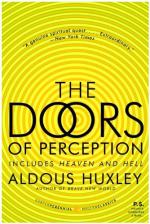
|
| Name: _________________________ | Period: ___________________ |
This test consists of 15 multiple choice questions and 5 short answer questions.
Multiple Choice Questions
1. According to the author, what is the most important effect of the first technique mentioned in Appendix 1?
(a) The cheapness and availability of the substance used.
(b) A marked increase in the subject's ability to see things with their eyes closed.
(c) Subjects perceiving that they are able to communicate with a higher power.
(d) The rarity of negative side effects in users.
2. What materials were often used for self-flagellation?
(a) Belts with nails driven through them.
(b) Whips made of knotted leather or iron wire.
(c) Flogs made from strips of leather or horsehair.
(d) Cat-o-nine-tails made from iron or steel.
3. How would a spiritual person interpret chemically-induced visionary experiences?
(a) A vision which is chemically-induced cannot be divine.
(b) All experiences are chemically-induced, including the divine ones, because that's just how our bodies work.
(c) Most truly spiritual people don't believe in visionary experiences.
(d) They were sent by God, and the chemicals had nothing to do with it.
4. Who used to say that when he self-flagellated God would deny him nothing?
(a) Benedict XVI.
(b) The Cure d'Ars.
(c) Saint John.
(d) The Apostle Paul.
5. Which is NOT a practice that mimics the effects which result from the first technique described in Appendix 1?
(a) Running.
(b) Shouting.
(c) Yogic breathing.
(d) Singing.
6. What is the second technique, described by the author in Appendix 1, for inducing a visionary state?
(a) Use of ambient music.
(b) Use of a repetitive hand movement.
(c) Use of a stroboscopic lamp.
(d) Use of various sound frequencies.
7. What development contributed greatly, according to the author, to pageantry and theatrical spectacle?
(a) Mass production of clothing and jewelry.
(b) Photography.
(c) Widespread literacy.
(d) Artificial lighting.
8. According to the author in Appendix 2, how would "proponents of a 'Nothing-But' philosophy" interpret mystical experiences?
(a) As a profoundly religious experience, independent from chemical changes.
(b) The result of mental illness.
(c) As simply the results of chemical changes in the brain.
(d) As an inexplicable glimpse into the Mind-At-Large.
9. How does the author respond when asked about spatial relationships?
(a) They have completely ceased to matter to him.
(b) They are warped and inaccurate.
(c) They don't seem to matter as much as they usually do.
(d) They are more noticeable and pronounced than usual.
10. In what type of plant is the substance being tested commonly found?
(a) A flower.
(b) A tree.
(c) A cactus.
(d) A bush.
11. What event was, according to the author, an example of ancient pageantry which was enriched and improved by technological advances?
(a) The coronation of Queen Elizabeth II.
(b) The first performance of "Romeo and Juliet" in a theater equipped with modern technology.
(c) The first motion picture.
(d) The inauguration of the first President, George Washington.
12. What results were produced when a researcher prodded parts of the brain with a fine electrode?
(a) The subjects were able to learn new languages and skills more efficiently.
(b) Various parts of the subjects' bodies twitched.
(c) The subjects recalled detailed and distant memories.
(d) The subjects experienced a variety of emotions.
13. The author feels that all human beings are naturally what?
(a) Solitary, but sometimes focused on others.
(b) Introspective and solitary.
(c) Introspective, but group-oriented.
(d) Solitary, but not introspective.
14. What substance is the author testing in the experiment?
(a) Mescalin.
(b) Angel dust.
(c) Acid.
(d) Cocaine.
15. According to Huxley, what causes negative visionary experiences?
(a) A negative outlook on life.
(b) An allergy to mescalin.
(c) Mental illness.
(d) The way that mescalin is broken down in the body.
Short Answer Questions
1. When did fireworks re-enter the world of popular entertainment, according to the author?
2. To what field of science does the author compare the human mind at the beginning of "Heaven and Hell"?
3. Why are marble and stone often particularly impressive materials in art?
4. According to the author, what is theatrical spectacle?
5. To what does the author compare someone fasting and self-flagellating, instead of using drugs, to achieve a visionary experience?
|
This section contains 729 words (approx. 3 pages at 300 words per page) |

|




